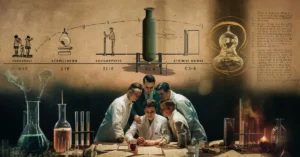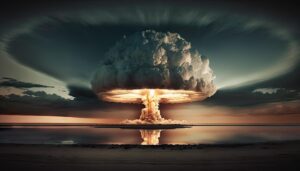The C38 atomic bomb was a game-changer in the world of powerful weapons. It wasn’t just any bomb—it was a huge leap in how destructive bombs could be. When the C38 atomic bomb was developed, it brought a whole new level of power and destruction.
In this blog post, we’ll explore what made the C38 atomic bomb so special and why it’s important to remember. We’ll look at its history, how it was made, and the big effects it had on the world.
What is the C38 Atomic Bomb
The C38 Atomic Bomb was one of the most powerful bombs ever created. It was different from regular bombs because it used nuclear energy to create a huge explosion. This made it way more powerful than anything before it. Imagine a bomb so strong that it could flatten a whole city in seconds!
Scientists worked hard to make the C38 Atomic Bomb. They used special materials and complex science to create it. When it was finally ready, it showed just how much damage a bomb could do. This new kind of bomb was not just about making a big bang; it changed how people thought about war.
Many people remember the C38 Atomic Bomb as a huge step in bomb technology. It was like moving from a tiny toy to a giant rocket ship. The power and impact of the C38 made it a very important topic in history and science.
How the C38 Atomic Bomb Changed Warfare
The C38 Atomic Bomb changed the way wars were fought. Before it, wars were fought with guns and traditional bombs. But this atomic bomb brought a whole new level of destruction. It made countries rethink their strategies and how they prepared for conflict.
With the C38 Atomic Bomb, countries had to think about more than just winning battles. They had to think about the massive destruction that a single bomb could cause. This new kind of bomb made wars even more dangerous and terrifying.
People realized that using such powerful bombs could have huge consequences. The C38 Atomic Bomb showed that war could lead to terrible damage on a much bigger scale than ever before. It changed not just how wars were fought but also how people talked about peace and safety.
The History Behind the C38 Atomic Bomb
The story of the C38 Atomic Bomb starts with scientists working during a time of great conflict. They were trying to create something that would have a big impact on the world. After a lot of hard work, they succeeded in making this super-powerful bomb.
During its development, the world was watching closely. The C38 Atomic Bomb represented a major breakthrough in bomb technology. It was a big deal because it showed just how much science and technology could advance in wartime.
This atomic bomb became a symbol of a new era in history. The C38 Atomic Bomb was not just a weapon; it was a turning point in how people saw the power of bombs and the potential for future conflicts.
How Scientists Made the C38 Atomic Bomb
Creating the C38 Atomic Bomb was no easy task. Scientists had to use advanced knowledge and special materials to build it. They worked in secret labs, experimenting with nuclear reactions to get the bomb just right.
The process was very complicated. Scientists had to figure out how to control the power of the atomic reaction to create the desired explosion. This meant a lot of careful planning and testing before the bomb was ready to use.
Making the C38 Atomic Bomb was a huge scientific achievement. It showed how much knowledge and skill were needed to create something so powerful. The work behind it was a mix of cutting-edge science and high-stakes experimentation.
Testing the C38 Atomic Bomb: What Happened
Testing the C38 Atomic Bomb was a big event. Scientists wanted to make sure it worked perfectly before using it. They set up tests in special locations to see how powerful the bomb really was.
During testing, the results were astonishing. The explosion from the C38 Atomic Bomb was much larger than anyone had expected. It proved that this new type of bomb was incredibly powerful and had the potential to cause massive damage.
The tests also showed how destructive nuclear bombs could be. The C38 Atomic Bomb was a clear example of the kind of impact these weapons could have. Testing it was an important step to understand its effects and readiness.
The C38 Atomic Bomb: Why It Was Used
The decision to use the C38 Atomic Bomb was driven by strategic considerations during wartime. The goal was to achieve a decisive advantage by deploying a weapon of unmatched power. Using the bomb was seen as a way to force a quick end to conflict.
Leaders believed that the massive impact of the bomb would compel the enemy to surrender. The use of the C38 was intended to demonstrate the overwhelming power of nuclear weapons, making it clear that resistance would lead to severe consequences.
However, the decision was also met with significant debate. The ethical and humanitarian implications of using such a destructive weapon were questioned. The choice to deploy the C38 Atomic Bomb reflected a complex mix of strategic calculations and moral considerations.
The Immediate Effects of the C38 Atomic Bomb
When the C38 Atomic Bomb was detonated, the immediate effects were catastrophic. The explosion caused widespread destruction, flattening buildings and causing fires. The impact was so severe that it left a lasting mark on the affected area.
The immediate aftermath saw a scene of chaos and devastation. The bomb’s explosion created a shockwave that affected a large area, resulting in significant loss of life and property. The scale of the destruction demonstrated the immense power of nuclear weapons.
The immediate effects of the bomb also had profound implications for how future conflicts were approached. The devastation served as a stark reminder of the destructive capabilities of nuclear weapons, influencing global policies and military strategies.
Lessons from the C38 Atomic Bomb: What Can We Learn
The C38 Atomic Bomb offers important lessons about the use of powerful technology. One key lesson is the need to carefully consider the consequences of such destructive weapons. Understanding the impact of the bomb helps us make better decisions about technology and warfare.
Another lesson is the importance of pursuing peace. The devastation caused by the C38 highlights why it’s crucial to avoid conflict and work towards diplomatic solutions. Learning from the past can guide us in preventing future use of such destructive weapons.
Additionally, the bomb teaches us about responsibility. It’s essential for scientists and leaders to consider the ethical implications of their work. The lessons from the C38 Atomic Bomb emphasize the need for responsible use of powerful technologies to ensure they contribute positively to society.
Political and Military Choices with the C38 Atomic Bomb
The decision to use the C38 Atomic Bomb involved significant political and military considerations. Leaders had to weigh the benefits of using such a powerful weapon against the potential consequences. This decision impacted military strategies and international relations.
The bomb’s development and use changed how military strategies were planned. Countries had to account for the possibility of nuclear conflict in their defense strategies. The presence of such a weapon added a new layer of complexity to military planning and decision-making.
Internationally, the use of the bomb led to increased tension and an arms race. The need to manage nuclear capabilities became a major focus for global diplomacy. The political and military choices surrounding the C38 Atomic Bomb shaped the course of future international relations and arms control efforts.
The C38 Atomic Bomb’s Impact on the Environment
The environmental impact of the C38 Atomic Bomb was significant. The explosion caused widespread damage to the natural surroundings, including contamination of the land and water. Radioactive fallout had long-lasting effects on the environment.
The bomb’s detonation resulted in immediate environmental damage. The radiation spread through the air, affecting ecosystems and wildlife. The long-term impact included persistent contamination that required extensive cleanup efforts.
Understanding the environmental effects of such weapons is crucial for future policy and technology development. The C38 Atomic Bomb’s impact highlights the need to consider environmental consequences when dealing with powerful technologies. Protecting our planet requires careful planning and consideration of all potential effects.
Ethical Questions About the C38 Atomic Bomb
The use of the C38 Atomic Bomb raised many ethical questions. Was it justifiable to use such a powerful weapon that caused immense destruction? The decision to deploy the bomb sparked debates about the moral implications of its use.
Ethical considerations include the value of human life versus the potential benefits of using the bomb. The massive destruction caused by the C38 led to discussions about whether such actions were morally acceptable. The ethical questions surrounding the bomb continue to be relevant in discussions about nuclear weapons.
Reflecting on the use of the C38 Atomic Bomb helps us understand the importance of moral responsibility in scientific advancements. The debates and questions that arose from its use emphasize the need for thoughtful consideration when dealing with powerful technologies.
The Long-Term Legacy of the C38 Atomic Bomb
The legacy of the C38 Atomic Bomb extends far beyond its immediate effects. It influenced the development of nuclear weapons and led to a global arms race. Countries began to build their own nuclear arsenals, shaping international security dynamics.
The bomb also left a psychological impact on society. The fear of nuclear conflict became a constant concern, affecting global politics and public attitudes. The legacy of the C38 Atomic Bomb is reflected in ongoing efforts to manage and control nuclear weapons.
The Impact of the C38 Atomic Bomb on Global Politics
The C38 Atomic Bomb had a major impact on global politics. After its use, nations began to focus more on nuclear weapons and their potential effects. This shift led to increased political tension and competition among countries.
In the aftermath of the C38’s deployment, many countries started building their own nuclear arsenals. This arms race created a climate of fear and suspicion worldwide. Nations became more cautious in their dealings with each other, knowing that any conflict could potentially lead to nuclear escalation.
International relations were forever changed by the presence of such powerful weapons. The C38 Atomic Bomb highlighted the need for new treaties and agreements to control nuclear arms and prevent future conflicts. Global politics shifted to include a major focus on nuclear diplomacy and disarmament.
The Role of the C38 Atomic Bomb in Shaping Modern Warfare
The C38 Atomic Bomb fundamentally changed modern warfare. Before its creation, wars were fought with conventional weapons. However, the development of such a powerful bomb introduced a new dimension to military strategy.
The threat of nuclear weapons made military leaders rethink their approaches. The bomb’s potential for massive destruction meant that strategies had to account for the possibility of nuclear conflict. This change led to the development of new military doctrines and defense mechanisms.
The presence of nuclear weapons like the C38 also influenced international military alliances. Countries formed new alliances and defense pacts to counter the threat of nuclear war. This shift in military strategy and alliances was a direct result of the bomb’s impact.
The Psychological Impact of the C38 Atomic Bomb
The psychological impact of the C38 Atomic Bomb was profound. The sight of such destruction left a deep mark on people’s minds. The fear of nuclear war became a constant concern for many, affecting daily life and international relations.
The bomb’s power and the devastation it caused led to widespread anxiety about the future. People lived with the knowledge that such a weapon could be used again, creating a pervasive sense of insecurity. This fear influenced cultural and political attitudes worldwide.
Understanding the psychological effects of the C38 Atomic Bomb helps us recognize the importance of nuclear disarmament. The lasting impact on society highlights the need to work towards a world where the threat of nuclear conflict is no longer a reality.
The C38 Atomic Bomb and Nuclear Non-Proliferation Efforts
The development of the C38 Atomic Bomb significantly influenced nuclear non-proliferation efforts. The destructive power of such a weapon highlighted the need to control and limit the spread of nuclear arms. This led to increased international focus on preventing the spread of nuclear technology.
In response to the C38’s impact, countries and organizations began working on treaties and agreements to prevent further proliferation. These efforts aimed to reduce the number of nuclear weapons and ensure that technology was not misused.
Nuclear non-proliferation became a key issue in global diplomacy. The legacy of the C38 Atomic Bomb underscored the importance of international cooperation to manage and reduce nuclear arsenals. Efforts continue to this day to promote disarmament and prevent new nations from acquiring nuclear weapons.
The Role of the C38 Atomic Bomb in Popular Culture
The C38 Atomic Bomb also made its mark on popular culture. Its impact on history and the dramatic nature of its use have been subjects of numerous films, books, and media. The bomb has become a symbol of both the power and the dangers of nuclear technology.
In movies and literature, the C38 is often portrayed as a turning point in history. These depictions reflect both fascination and fear, illustrating the bomb’s role in shaping public perception of nuclear weapons.
Popular culture has used the C38 Atomic Bomb as a way to explore themes of power, destruction, and morality. The bomb’s legacy continues to influence how we think about technology and its potential consequences, making it a lasting symbol in modern media.
The C38 Atomic Bomb’s Influence on Scientific Research
The creation and use of the C38 Atomic Bomb had a significant impact on scientific research. The advanced technology and methods used to develop the bomb pushed the boundaries of nuclear science. This led to new discoveries and advancements in related fields.
Researchers studied the bomb’s effects and the underlying science to understand its power better. These studies contributed to advancements in nuclear physics and engineering. The knowledge gained from the C38’s development has been used in various scientific and industrial applications.
The influence of the C38 Atomic Bomb extends beyond military technology. Its impact on scientific research has shaped the way we understand and use nuclear energy. This has had both positive and negative consequences, influencing fields ranging from medicine to energy production.
The C38 Atomic Bomb and Its Effect on International Treaties
The deployment of the C38 Atomic Bomb played a crucial role in shaping international treaties on nuclear weapons. The bomb’s use demonstrated the need for agreements to control and limit nuclear arms. This led to the creation of various treaties aimed at managing nuclear proliferation.
One of the key outcomes was the establishment of treaties such as the Nuclear Non-Proliferation Treaty (NPT). These agreements sought to prevent the spread of nuclear weapons and promote disarmament. The C38 Atomic Bomb’s legacy can be seen in the ongoing efforts to negotiate and enforce these international agreements.
International treaties have been crucial in managing the risks associated with nuclear weapons. The impact of the C38 highlighted the importance of global cooperation to prevent the further use of such destructive technology. Treaties continue to play a vital role in maintaining global security and stability.
The Legacy of the C38 Atomic Bomb in Education and Awareness
The legacy of the C38 Atomic Bomb has influenced education and public awareness about nuclear weapons. Schools and institutions often use the history of the bomb to teach about the dangers of nuclear technology and the importance of peace.
Educational programs and materials highlight the bomb’s impact and the lessons learned from its use. By studying the C38, students and the public can gain a better understanding of nuclear science and the ethical considerations involved.
Awareness campaigns and educational efforts aim to promote understanding and prevent future conflicts. The legacy of the C38 Atomic Bomb serves as a powerful reminder of the need for responsible use of technology and the importance of working towards a peaceful world.
The C38 Atomic Bomb’s Impact on Military Technology Advancements
The C38 Atomic Bomb influenced many advancements in military technology. Its development marked a significant shift in how weapons were designed and used. The need to counter such powerful weapons led to new innovations and improvements in military technology.
Following the C38, military technology advanced rapidly to include better defense systems and more sophisticated weaponry. The bomb’s impact drove research into developing new technologies to protect against nuclear threats and improve overall military capability.
The legacy of the C38 Atomic Bomb can be seen in the ongoing development of advanced military technologies. The lessons learned from its use continue to shape how military technology evolves, ensuring that future advancements consider both effectiveness and safety.
Conclusion
The C38 Atomic Bomb was a huge leap in technology that changed the world in many ways. It showed just how powerful and destructive nuclear weapons can be, influencing how wars are fought and how countries deal with each other. This bomb made everyone think hard about the consequences of using such powerful tools and led to new rules and agreements to try to keep the world safer.
Looking back at the C38 Atomic Bomb helps us learn important lessons about technology and peace. It reminds us that while science and technology can do amazing things, they also come with big responsibilities. By remembering the past and working together, we can hope to build a future where such dangerous weapons are no longer needed and where we all live in a safer, more peaceful world.








